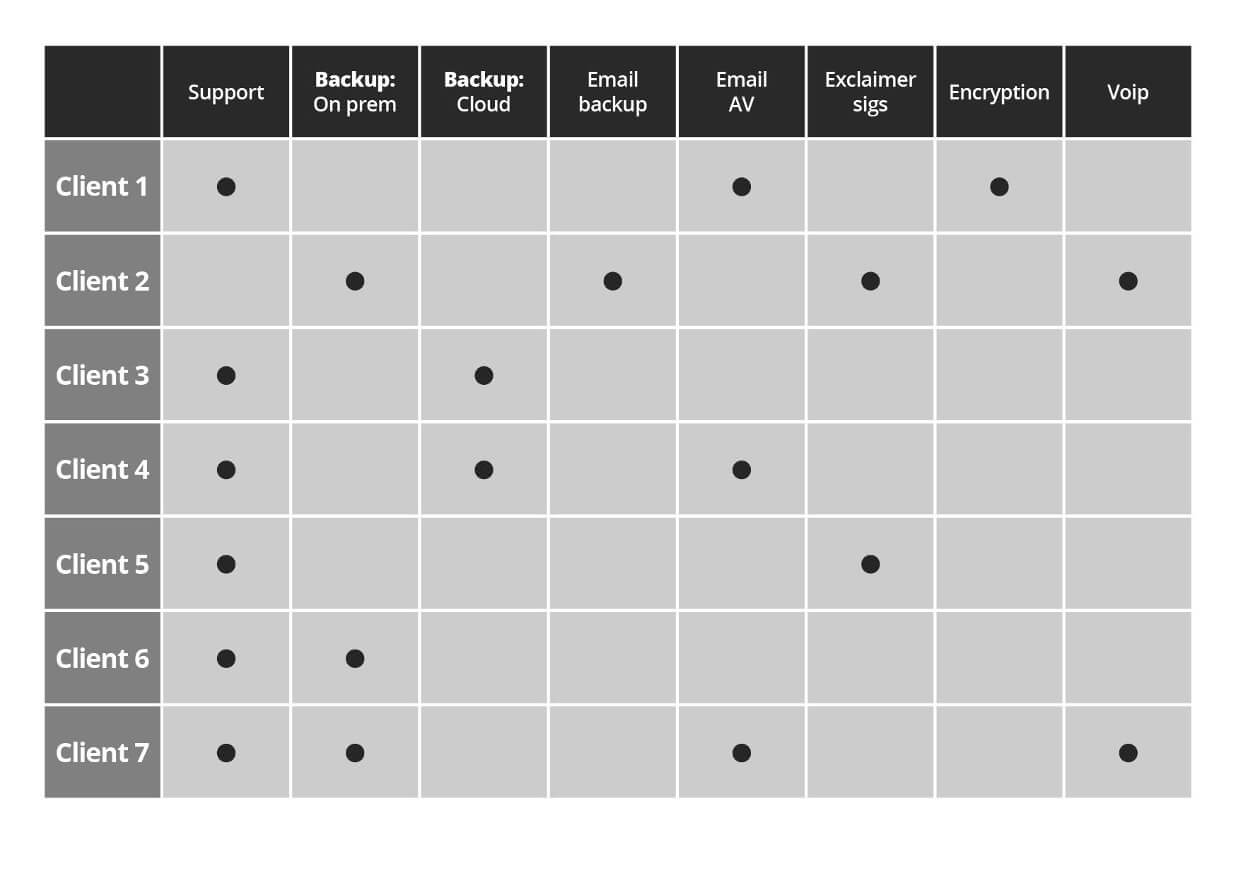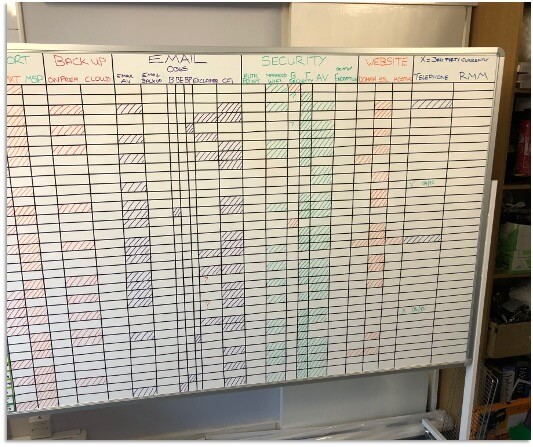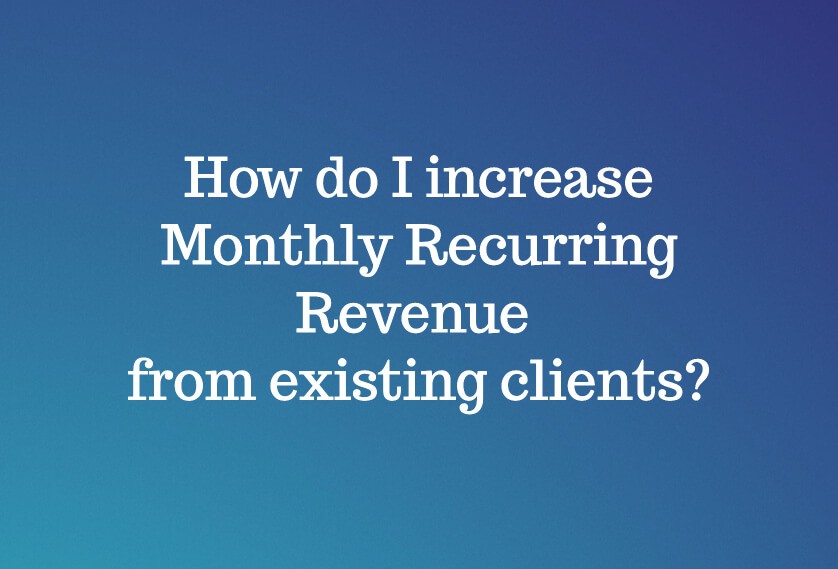The easiest way to increase your turnover and net profits is by generating more income from your existing clients. In this article, you'll discover the marketing strategy you need to do this for your MSP
Jump to
Part one: The only 3 ways to grow your MSP
Part two: Say hello to the profit matrix for MSPs
Part three: How do you find out what your clients want?
Part four: How to get your technicians to sell for you
As business owners, we all spend a lot of our time thinking about MONEY 😃
Specifically, how we can make more of it.
Because if we want to reach our business goals... grow... do more... lack of enough cash is the main thing standing in our way, right? Because we have salaries to cover, overheads to meet, and suppliers to pay.
So what every MSP needs is a fail safe way of putting more money in the bank without spending a fortune in the process.
New client acquisition is expensive; really expensive. It's always more profitable to sell more to your existing clients.
And that’s exactly what this guide is about.
The best news: it’s really not complicated. In fact, you can implement this for your MSP straightaway without spending money on advertising, experts, or changing what you sell.
The only prerequisite for this to work is that your business has been running for at least three years, and has lots of clients.
Is this you? Let’s get started.
The only 3 ways to grow your MSP
If you’ve read any of my books, or blogs, or even heard me speak, you’ll know that there are only three ways to grow your MSP.
- Get more clients
- Get those clients to buy more often
- Get those clients to spend more when they buy
When it comes to marketing, most MSPs focus on getting more clients. The more people you have buying, the more money you make, right?
Well, not always. It’s not uncommon to see businesses attracting loads of new clients yet still struggling with cash flow problems. It’s because getting new clients is expensive. The cost of attracting, winning, and onboarding those new clients really racks up.
So, the fastest, most robust ways to grow your business are numbers 2 and 3. It’s what I call “money on the table” and guess what? You’re leaving it there.
Worse, if you continue to leave money on the table, you may even find that you lose clients.
Let me explain.
Think about one of your good, happy clients. Let’s call them Joe. Joe pays his fee on time every month. He isn’t much bother, just makes the occasional call to your help desk for something relatively simple. You don’t think about him very often.
What you don’t realise is that in the background Joe is really building his business. He’s got BIG plans. And one day he might wake up and decide that his business is too big for you to support now. Or that you’re not offering the level of support that he now perceives he needs.
The first you’ll know about this is when he has already made the decision and has found a replacement MSP. It’s too late for you to snatch that money off the table.
But imagine if you’d spoken to Joe more often. If you'd set up opportunities to ask him how business was going. What his plans for growth were. And what problems he may need help with. You could’ve identified some huge opportunities for your business to sell him more of your Monthly Recurring Revenue (MRR) services.
And all with a single conversation.
There’s a great way to go about this conversation too, but I’ll get to that a little later. First, I want to introduce you to the tool that has the potential to add thousands of extra profit to your business, each and every month.
Say hello to the profit matrix for MSPs
No it's got nothing to do with Neo and Trinity 😃
Your profit matrix is a simple visual tool that shows you exactly which clients are buying what... and therefore which clients are yet to buy additional services.
Yes, this info is in your PSA. But it's much more powerful when you gather it together and present it differently.
It may sound a little complicated, but trust me when I say this will take you less than an hour to complete.
Open an Excel spreadsheet and along the top list everything you sell. A different MRR service in each column.
Then, down the side list all of your clients; one client to a row.
So far, so simple.
All you need to do now is go along each client and fill in each cell where they already buy that MRR service from you.
When you’ve done this for every client, you’ve successfully identified your extra profit potential. It's sat there in the blank cells. Where the clients aren't buying the service.
Well done you. Here's what it might look like:

PRO TIP: If you really want to bring the profit matrix to life, in every empty box write in the value of the revenue if the client bought the service. You'll literally have thousands and thousands of extra revenue sat on the board, waiting for some of it to be collected.
Here's how to take that to the next level. It’s great to have this on an Excel spreadsheet, but what I’d suggest for it to make the most impact is to put it up on a whiteboard somewhere everyone can see it.
It’ll always be there as a reminder and your technicians can see at a glance where there are opportunities to sell something else when they’re speaking to a client (I’ll speak a little later about how best to get them to do this, too).
This is what your offline profit matrix might look like:

Another great thing about the profit matrix is that it can show you if you’re not offering enough products or services to generate extra Monthly Recurring Revenue.
Maybe you coiuld add different flavours of your current services? Or better versions for some clients to upgrade to?
Remember, the goal here is to grow the average per seat revenue of every client. This isn't about hard selling. It's about telling your clients what's available, and educating them why they should buy it. Some will buy it because they want it, some won't buy. That's OK.
Because people hate being sold to... but they love to buy. That leads on to an interesting question...
How do you find out what your clients want?
The simple answer is... you ask them!
But the key here is never to turn the question into a sales pitch. Being a sales person first and account manager second can damage your relationship. If your clients feel that they’re going to be sold to each time they speak to you, they’ll stop taking your calls.
Here’s what you do instead: you take your client out to lunch. And you position it as a strategic IT review (also known as a Quarterly Business Review. I renamed it as I think quarterly is overkill for most MSPs and clients).
Choose a good client who you don’t have to think about too often (remember Joe? He’d be one to do this with). Choose a nice locally-owned restaurant - not McDonalds, but not the most expensive place in town either.
Tell your client you’re buying them lunch so that you can perform a strategic IT review for their business, and they’ll need to be out of the office for an hour or so.
(Note - the power of getting them out of their building is you get their brain focused on all the right things, and not the day to day clutter that bogs down their thinking. If they decline lunch and insist you meet in their building, try your hardest to make sure it's in a meeting room and not their normal office. Most people are happy to have a free lunch and enjoy a bit of luxury in an otherwise busy day).
An important thing to remember is not to waste your time during this lunch. It’s all too easy to start catching up and discussing current support issues, and before you know it, lunch is over and you haven’t even started on the review.
Allow just 10 minutes for chatting, then swiftly move on to business. Your goal is to allow your client to talk about their business for the entire lunch. You want to hear all about their plans and goals for the future. So that at the end you can suggest how you can help them achieve their goals.
All without selling.
Your client will be able to decide if it’s the right option for their business, with no pressure.
Here are some questions you could ask during your strategic review:
- Since we last met, in the context of your technology, what’s gone well?
- What’s not gone so well?
- What’s holding you back?
- What are your priorities for the next 12 months?
- What have been your biggest headaches?
- What keeps you awake at 4am?
- How can we help?
You should also discuss their 3-1-3. That’s what they’ll be doing in:
- 3 months
- 1 year, and
- 3 years
To cover their short- mid- and long-term goals for the business.
Do this every 12 months with your good clients. Or every 6 months for particularly fast moving clients, to make sure you don’t miss out on any opportunities.
You should also tell them from day one that you do this as a standard part of their partnership with you, and don’t make it optional (unless they are a bad client who you'll be firing one day).
Of course, the other excellent benefit of regular strategic IT reviews is that it really strengthens your relationship with your clients. It’s amazing for retention.
Your clients stick with you because they like you. They'll leave you because they don’t. It’s an emotional decision not a cognitive one. And if you’re making time for them to talk about their favourite subject (themselves and their business), and really getting to know them, the chances are that they’ll like you even more.
Boom.
People buy things in two different ways; either with our brain or with our heart. Our brains call the shots when it comes to the things we need. These are logical, sensible, cognitive decisions.
If all of our decisions were made by our brains, we’d all be driving around in the same, reliable, low cost car, for example. It’s the sensible thing to do.
But we’re not. Many of us drive around in £40,000 - £50,000 cars, because we want them. They make us feel good. And that’s an example of an emotional decision.
For the things that we want, the brain will ‘ok’ the decision, but it’s our heart that’s calling the shots.
Most considered purchases (especially picking an IT support company) are made emotively, and our brains simply justify the decision for us. They're a rubber stamp on the heart's decision.
We could get a Ford, but that Audi would be more reliable, safer, and more comfortable for long journeys... says the heart, self justifying its decision 😃
And this is no different when it comes to business decisions. Although the decision makers are buying for a business, they still ultimately make a decision lead by their heart.
This is the reason you’ll see big marketing agencies wining and dining decision makers for the companies they work with, or want to work with. They want to create a feeling of positivity and a good rapport with these people. The work they do is actually a very small part of the process, believe it or not.
How to get your technicians to sell for you
Of course, there may have to be a small element of selling at your strategic review. You’ll suggest some of the ways that your MSP can solve some of the issues your client is currently facing, or perhaps ways you can help them to reach their business goals a little faster. And your client will either go for it on the spot, or they’ll go away and have a think about it and come back to you when they’ve made a decision.
But wouldn’t it be great if you had a way of selling additional products or services more regularly than when you meet them every 12 months?
Remember that profit matrix we spoke about earlier? Here’s where that can come in.
As well as your fancy Excel spreadsheet, you should also have a dedicated whiteboard with this information on it, in a place where all of your technicians can see it all of the time. Because they’re speaking to your clients every day. They can identify opportunities to help your clients even further whenever they speak to them.
We know that people love to buy, but hate being sold to. Well your techs love to fix people’s problems but hate selling. It’s a match made in heaven. And what it creates is a source of authentic upselling.
Authentic upselling is where something extra is sold in your business that benefits both parties. Your client has a problem solved and your business creates an additional source of Monthly Recurring Revenue.
A good non-IT example of this is when you’re checking into a hotel and they tell you for an extra £15 they can add breakfast for two people to your booking, “saving” you £10 on the normal cost. You justify the treat, because you’re away... and the hotel makes extra profit.
Your techs are speaking to clients every day, so they should be identifying opportunities to help your clients even further. And your clients should be happily buying these extra services, because they want it on an emotional level - they love your company and it would solve another problem for them.
But if your MSP is like most, your techs aren’t selling more, are they?
So why is this? Is it fear? Do they lack the motivation? Should you be incentivising sales?
The answer to that last one is no! Adding an incentive actually works to decrease their performance. Read a book called Drive, by Daniel Pink which explains this in detail.
Instead, you need to focus your techs on the benefit to your clients.
Get into the habit of having daily huddles (or whatever you want to call them in your business). Each morning, speak about some things that are going well for your techs and clients, and some things that aren’t going so well.
As an example, your tech Dave might tell you that he had a total nightmare with Client A yesterday. Their server died and their manual backup hadn't been done for a few days, so they lost loads of data.
You could say to Dave, “Ah, if only they’d been on X (your monthly data backup service). Let’s over-support them today to get them back up and running quickly”.
Now Dave can see the benefit of your clients being on your monthly data back-up service. It’s better for them.
Then another tech Emily may tell you that Client B had a lucky escape, because they had a big problem, but because they’re on your unlimited support package, it was picked up and fixed before they even noticed the issue.
Now Emily and your other technicians all see that the unlimited support package is better for your clients.
See how this works?
And if you’re doing this every day, you are reinforcing that message time and time again, drip feeding the benefit of everything you sell. It may take a while, but eventually your techs are going to start authentically selling to your clients when they spot an opportunity to do so.
And it won’t come across as selling to your clients. It'll come across as problem solving.
One crucial element that can determine the success or failure of this approach is making sure that your technicians all know your products and services inside out. One way to do this is to schedule regular education sessions for the whole team, to refresh them on your services - even the ones you’ve sold for years.
Make it fun, give them pizza, play games. Importantly, focus on the benefits to your clients, because that’s what’s important to your team.
Here’s an example…
Feature: Unlimited support
Benefit: No matter what goes wrong, you’ll never have to worry about the bill
Feature: Proactive servicing
Benefit: Your computer is less likely to go wrong
One other practical thing that can help technicians to sell is to remove all the fear and discomfort from it.
So you could say to them if they spot an opportunity to help a client with one of your services, they should mention is to the client and then drop you an email. You can do the actual selling.






